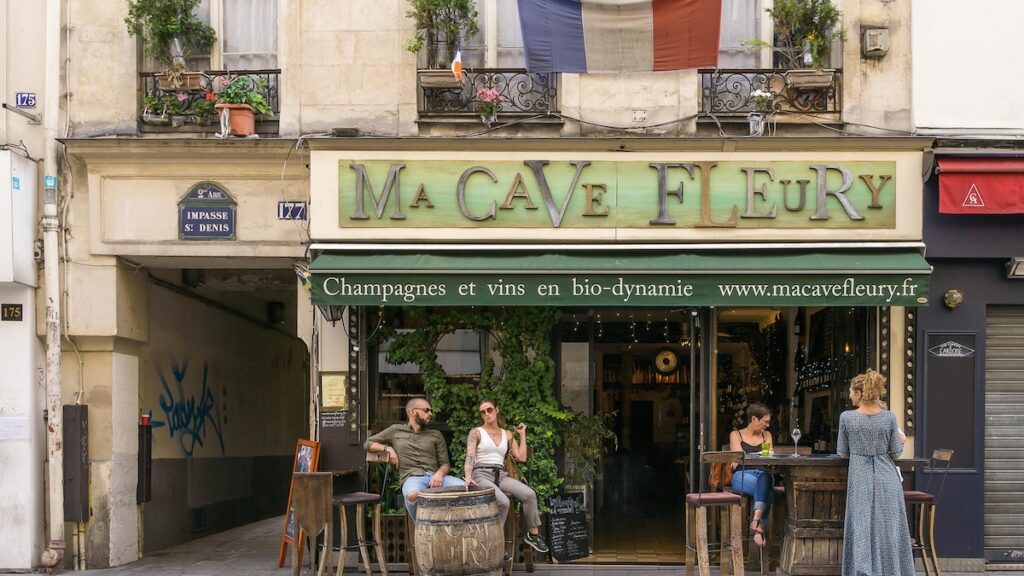This article was produced by National Geographic Traveller (UK).
It’s a Sunday and the hillsides around the Sacré Coeur are packed with people. But they’re not worshippers, nor the usual crowd of Montmartre selfie-seekers primed for a panorama of Paris unfurling from the basilica’s lofty ramparts. Today, the mission here is to discover wine. It’s mid-October and the annual Fête des Vendanges is in full swing — a festival ostensibly celebrating the grape harvest from the nearby Clos Montmartre vineyard. But so teeny is this patch of historic Parisian vines that the fete also brings viticulturists from across France to showcase their wares, resulting in an annual quaffing free-for-all.
I wade through the throng, passing festival-goers sampling oysters from Nouvelle-Aquitaine with Champagne from family-owned producer Jean-Pierre Marniquet. Temptations are myriad but I’m not here to drink — yet. First, I’m joining a walking tour to learn about the history of winemaking in Montmartre, a tradition with Roman origins but one that few travellers would associate with Paris today.
At one time, the Île-de-France region in which Paris sits was France’s largest wine-producing area, and this famously bohemian neighbourhood was part of it. “Montmartre was once a cheap countryside retreat. A place of dairy cows and wine, full of windmills” says my guide Geoffrey Finch — a Canadian expat nattily dressed in a trilby hat. “We would’ve once been surrounded by vineyards here,” he explains when I meet him nearby at Eglise St Pierre, Paris’s second-oldest surviving church, once part of a 12th-century Benedictine abbey. “The abbey produced immense amounts of wine. And not just for the sacrament — to make money. Winemaking fed the local economy,” he explains. “Viticulture was a prosperous thing to get into.”
The annual Fête des Vendanges celebrates the grape harvest from the nearby Clos Montmartre vineyard.
Photograph by Huy Anh Nguyen, Alamy
As Geoffrey leads me around the area’s steep, cobbled backstreets, I learn that Montmartre’s winemaking funded much of the neighbourhood’s gothic architecture. The area’s wine and cheap rent also drew artists. We pause outside the La Bonne Franquette, a cafe frequented by the likes of Monet, Toulouse-Lautrec, Renoir and Van Gogh. The latter recreated La Bonne Franquette’s garden in his 1886 painting La Guinguette, on display in Paris’s Musée d’Orsay.
Urbanisation pushed winemaking out of Île-de-France from the 19th century — but the artists stayed. Our walk takes us past the Cité Internationale des Arts, a large institutional block of apartments. “It’s one of a few affordable artists’ residences left in Paris,” says Geoffrey, also pointing out a neighbouring building that once hosted the Clinique du Montmartre, a shelter for artists and poets whose nerves couldn’t be soothed with wine alone. One inhabitant was Gerard de Nerval, whose habit of walking his pet lobster in the 1840s, Geoffrey tells us, later inspired Dali. We stop to admire some vines growing in the gardens of Commanderie du Clos Montmartre. “Once a firefighters’ water tower,” says Geoffrey. “Now it’s a place for winemakers to gather.”
Île-de-France is fast reviving its viticulture. Several villages are now included in the Champagne zone and hundreds of small vineyards have blossomed in recent decades. In 2019, the region was recognised as an official geographical designation: winemaking in Paris is back, says Geoffrey.
The Île-de-France region, in which Paris sits, was once France’s largest wine-producing area.
Photograph by Alexander Spatari, Getty Images
Our small group of vinophile travellers progresses up to the Musée de Montmartre. From the gardens of this local history museum, which adjoins Clos Montmartre winery, we have a good vantage point to study the oldest continuously producing vineyard in the city limits. Founded in 1933, Clos Montmartre’s vines are steeply raked down a 16,748sq-ft plot, co-planted with flowers and fruit trees to enrich the soil. Today, about 25% of the vineyard is planted with the same varietals that originally grew here, along with some gamay and pinot, but the majority crop is disease-resistant hybrids; all of which produces some 1,700 bottles of wine annually. “Most doesn’t leave the area,” says Geoffrey.
And at Chez Eugène, a plant-filled bistro in nearby Place du Tertre, we finally get to taste some: Clos Montmartre Cuvée du Sport, Fête des Vendanges. The red from 2022 is young and fruity and induces a few wrinkled noses from our group. “Yeah, it’s a bit of a mess,” says Geoffrey. But, like all the wines we try, it’s an organic, low-intervention variety currently favoured by savvy Parisians.
We taste several others too, including a fruity, dry Sauvignon-like Fié Gris from the Loire and a 2022 Beaujolais from central France, and Geoffrey encourages us to guess flavours with impunity, offering a crash course in French wine regions as we go. Plates of cheese and sourdough arrive to steady the ship; before long, Geoffrey is quoting Baudelaire: “It is time to be drunk! So as not to be the martyred slaves of time, be drunk, be continually drunk! On wine, on poetry or on virtue — as you wish.” The streets of Montmartre outside, still humming with the sound of wine festival revelry, seem to agree.
How to do it:
Geoffrey Finch hosts several group wine walks in different areas of Paris. Three hours from €75 (£64) per person, including a guided tasting.
Stay at the 25hours Hotel, by Gare du Nord, from €184 (£157).
Published in the June 2024 issue of National Geographic Traveller (UK).
To subscribe to National Geographic Traveller (UK) magazine click here. (Available in select countries only).
>>> Read full article>>>
Copyright for syndicated content belongs to the linked Source : National Geographic – https://www.nationalgeographic.com/travel/article/winemaking-paris-vineyards-montmartre
